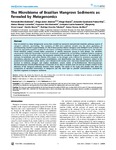Please use this identifier to cite or link to this item:
http://www.alice.cnptia.embrapa.br/alice/handle/doc/943451| Title: | The microbiome of brazilian mangrove sediments as revealed by metagenomics. |
| Authors: | ANDREOTE, F. D.  JIMENEZ, D. J.   CHAVES, D.   DIAS, A. C. F.   LUVIZOTTO, D. M.   DINI-ANDREOTE, F.   FASANELLA, C. C.   VARON LOPEZ, M.   BAENA, S.   TAKETANI, R. G.   MELO, I. S. de   |
| Affiliation: | FERNANDO DINI ANDREOTE, ESALQ-USP; DIEGO JAVIER JIMENEZ, Pontificia UNiversidad Javeriana; DIEOGO CHAVES, Colombian Center for Genomic and Bioinformatics from Extreme Environments; ARMANDO CAVALCANTE FRANCO DIAS, ESALQ-USP; DANICE MAZZER LUVIZOTTO, ESALQ-USP; FRANCISCO DINI-ANDREOTE, ESALQ-USP; CRISTIANE CIPOLA FASANELLA, ESALQ-USP; MARYEIMY VARON LOPEZ, ESALQ-USP; SANDRA BAENA, Pontificia Universidad Javeriana; RODRIGO GOUVÊA TAKETANI; ITAMAR SOARES DE MELO, CNPMA. |
| Date Issued: | 2012 |
| Citation: | Plos One, v. 7, n. 6, 14 p., 2012. |
| Description: | ABSTRACT: Here we embark in a deep metagenomic survey that revealed the taxonomic and potential metabolic pathways aspects of mangrove sediment microbiology. The extraction of DNA from sediment samples and the direct application of pyrosequencing resulted in approximately 215 Mb of data from four distinct mangrove areas (BrMgv01 to 04) in Brazil. The taxonomic approaches applied revealed the dominance of Deltaproteobacteria and Gammaproteobacteria in the samples. Paired statistical analysis showed higher proportions of specific taxonomic groups in each dataset. The metabolic reconstruction indicated the possible occurrence of processes modulated by the prevailing conditions found in mangrove sediments. In terms of carbon cycling, the sequences indicated the prevalence of genes involved in the metabolism of methane, formaldehyde, and carbon dioxide. With respect to the nitrogen cycle, evidence for sequences associated with dissimilatory reduction of nitrate, nitrogen immobilization, and denitrification was detected. Sequences related to the production of adenylsulfate, sulfite, and H2S were relevant to the sulphur cycle. These data indicate that the microbial core involved in methane, nitrogen, and sulphur metabolism consists mainly of Burkholderiaceae, Planctomycetaceae, Rhodobacteraceae, and Desulfobacteraceae. Comparison of our data to datasets from soil and sea samples resulted in the allotment of the mangrove sediments between those samples. The results of this study add valuable data about the composition of microbial communities in mangroves and also shed light on possible transformations promoted by microbial organisms in mangrove sediments. |
| Thesagro: | Mangue Bactéria Sedimento |
| NAL Thesaurus: | Mangrove forests Sediments Metagenomics Delta-Proteobacteria Gamma-Proteobacteria |
| Keywords: | Metagenômica |
| Type of Material: | Artigo de periódico |
| Access: | openAccess |
| Appears in Collections: | Artigo em periódico indexado (CNPMA)  |
Files in This Item:
| File | Description | Size | Format | |
|---|---|---|---|---|
| 2012AP59.pdf | 3.09 MB | Adobe PDF |  View/Open |









